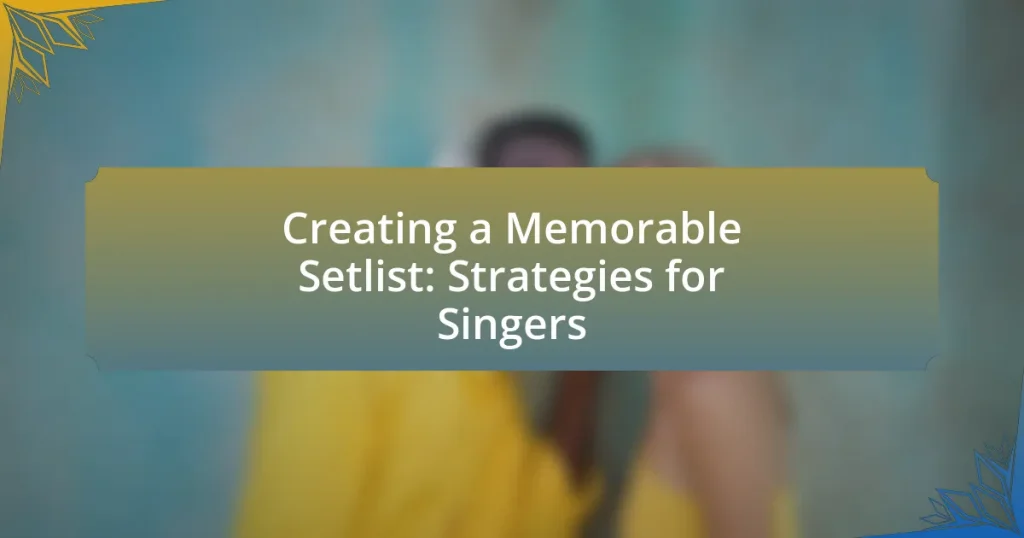Creating a memorable setlist is essential for singers as it directly influences audience engagement and emotional response during performances. This article outlines the importance of a well-crafted setlist, emphasizing elements such as song selection, flow, and thematic coherence. It discusses strategies for tailoring setlists to different audiences and venues, the impact of rehearsal on performance quality, and common mistakes to avoid. Additionally, it highlights best practices for finalizing a setlist and the role of feedback and tools in enhancing setlist organization and planning.

What is a Memorable Setlist for Singers?
A memorable setlist for singers is a carefully curated sequence of songs that engages the audience and showcases the artist’s range and style. This setlist typically includes a mix of popular hits, fan favorites, and new material to maintain interest and emotional connection throughout the performance. Research indicates that a well-structured setlist can enhance audience enjoyment and retention, with studies showing that varied tempos and dynamics can significantly impact audience engagement levels. For instance, incorporating a balance of upbeat songs and slower ballads can create an emotional journey, keeping the audience invested in the performance.
Why is a well-crafted setlist important for performances?
A well-crafted setlist is important for performances because it directly influences audience engagement and emotional response. A thoughtfully arranged setlist can create a dynamic flow, maintaining energy levels and ensuring that the performance resonates with the audience. Research indicates that performances with strategic song placement can enhance the overall experience, as transitions between songs can evoke specific emotions and memories, leading to a more memorable event. For instance, a study published in the Journal of Music Psychology highlights that audiences are more likely to connect with performances that have a clear narrative or thematic progression, demonstrating the significance of a well-structured setlist in maximizing impact.
How does a setlist impact audience engagement?
A setlist significantly impacts audience engagement by influencing the flow and emotional journey of a performance. When a setlist is thoughtfully curated, it can create a dynamic experience that resonates with the audience, encouraging participation and emotional connection. For instance, research indicates that performances with varied tempos and emotional highs and lows can enhance audience involvement, as seen in studies on concert psychology, which show that well-structured setlists lead to increased audience satisfaction and interaction.
What role does a setlist play in a singer’s artistic expression?
A setlist plays a crucial role in a singer’s artistic expression by curating the sequence and selection of songs that convey a specific emotional journey or narrative. This intentional arrangement allows the artist to showcase their musical identity, highlight thematic connections between songs, and engage the audience effectively. For instance, a well-structured setlist can transition from high-energy tracks to more introspective pieces, creating a dynamic flow that enhances the overall performance experience. Additionally, studies have shown that setlists can influence audience perception and emotional response, reinforcing the singer’s artistic vision and intent during live performances.
What elements contribute to a memorable setlist?
A memorable setlist is primarily influenced by song selection, flow, audience engagement, and thematic coherence. Song selection involves choosing popular hits, fan favorites, and deep cuts that resonate with the audience, ensuring a mix that maintains interest. Flow refers to the arrangement of songs to create a dynamic experience, balancing high-energy tracks with slower ballads to manage the audience’s emotional journey. Audience engagement is crucial; incorporating sing-alongs, call-and-response segments, or unexpected covers can enhance the connection between the performer and the crowd. Thematic coherence ties the setlist together, whether through lyrical themes, musical styles, or a narrative arc, creating a cohesive experience. These elements collectively contribute to a setlist that leaves a lasting impression on the audience.
How do song selection and order affect the overall experience?
Song selection and order significantly influence the overall experience by shaping the emotional journey and engagement of the audience. A well-curated setlist can create a narrative arc, transitioning from high-energy songs to more introspective pieces, which maintains audience interest and emotional connection. Research indicates that audiences respond positively to dynamic contrasts in tempo and mood, enhancing their enjoyment and retention of the performance. For example, a study published in the Journal of Music Psychology found that varied song order can lead to increased audience satisfaction and memorability, as it allows for emotional peaks and valleys that resonate with listeners.
What genres or themes should be considered when creating a setlist?
When creating a setlist, genres and themes such as pop, rock, country, hip-hop, and ballads should be considered to cater to diverse audience preferences. Each genre brings its own emotional resonance and energy level, which can enhance the overall concert experience. For instance, incorporating upbeat pop songs can energize the crowd, while slower ballads can provide emotional depth and contrast. Additionally, themes like love, empowerment, and nostalgia can create a cohesive narrative throughout the performance, engaging the audience on a deeper level. Research indicates that setlists that balance various genres and themes tend to result in higher audience satisfaction and engagement, as they appeal to a wider demographic and maintain interest throughout the performance.
How can singers tailor their setlists to different audiences?
Singers can tailor their setlists to different audiences by analyzing the demographic and cultural preferences of the audience, selecting songs that resonate with those characteristics. For instance, a singer performing at a wedding may choose romantic ballads, while a concert for a younger crowd might feature upbeat pop hits. Research indicates that audience engagement increases when performers align their music choices with the listeners’ tastes, as seen in a study by the University of Southern California, which found that familiarity with songs enhances emotional connection and enjoyment. By considering factors such as age, cultural background, and the event’s context, singers can create a setlist that maximizes audience satisfaction and participation.
What factors should be considered when assessing the audience’s preferences?
When assessing the audience’s preferences, factors such as demographics, cultural background, and previous engagement with similar performances should be considered. Demographics, including age, gender, and location, influence musical tastes and expectations; for instance, younger audiences may prefer contemporary hits while older audiences might favor classic songs. Cultural background shapes the types of music that resonate with different groups, as certain genres may hold particular significance in specific cultures. Additionally, analyzing previous engagement, such as audience reactions to past performances or popular songs within the community, provides insight into what the audience enjoys. These factors collectively inform the selection of a setlist that aligns with the audience’s preferences, enhancing their overall experience.
How can a singer adapt their setlist for various venues or events?
A singer can adapt their setlist for various venues or events by considering the audience size, venue acoustics, and the event’s theme. For instance, in smaller, intimate venues, a singer might choose softer, more personal songs to create a connection with the audience, while in larger venues, they may opt for high-energy tracks that engage a bigger crowd. Additionally, understanding the acoustics of the venue allows the singer to select songs that best suit the sound environment, ensuring clarity and impact. The event’s theme also plays a crucial role; for example, a wedding may require romantic ballads, whereas a festival might call for upbeat, danceable tracks. This strategic selection enhances the overall experience for the audience and aligns with the specific context of the performance.

What strategies can singers use to create an effective setlist?
Singers can create an effective setlist by strategically organizing songs to enhance audience engagement and emotional flow. This involves starting with a strong opening number to capture attention, incorporating a mix of tempos and styles to maintain interest, and placing popular or high-energy songs at key points to energize the crowd. Additionally, singers should consider the narrative arc of the performance, ensuring that the setlist tells a cohesive story or journey. Research indicates that well-structured setlists can significantly improve audience satisfaction and retention, as evidenced by studies showing that concerts with varied pacing and emotional dynamics lead to higher audience engagement levels.
How can singers balance popular hits with lesser-known songs?
Singers can balance popular hits with lesser-known songs by strategically interspersing the two within their setlist. This approach maintains audience engagement through familiar tracks while showcasing artistic depth with lesser-known material. For instance, placing a popular hit at the beginning or end of a set can create a strong emotional connection, while inserting a lesser-known song in between can provide a refreshing contrast and highlight the singer’s versatility. Research indicates that audiences appreciate variety, as evidenced by a study from the University of Southern California, which found that setlists featuring a mix of familiar and unfamiliar songs resulted in higher overall audience satisfaction.
What techniques can be used to introduce new material to the audience?
Techniques to introduce new material to the audience include storytelling, engaging visuals, and interactive elements. Storytelling captivates the audience by providing context and emotional connection to the new material, making it more relatable and memorable. Engaging visuals, such as slides or videos, can enhance understanding and retention by illustrating key points. Interactive elements, like audience participation or Q&A sessions, foster a connection and encourage investment in the new content. These techniques are supported by research indicating that storytelling can increase audience engagement by up to 65%, while visuals can improve information retention by 42%.
How can a singer maintain energy and flow throughout the performance?
A singer can maintain energy and flow throughout the performance by strategically selecting songs that create a dynamic and engaging setlist. This involves balancing high-energy tracks with slower songs to manage audience engagement and emotional pacing. Research indicates that varied tempos and styles can enhance audience retention and enjoyment, as demonstrated in studies on concert dynamics, which show that well-structured setlists can lead to increased audience participation and satisfaction. Additionally, incorporating seamless transitions between songs helps sustain momentum, allowing the singer to keep the audience engaged without noticeable breaks.
What role does rehearsal play in setlist preparation?
Rehearsal is essential in setlist preparation as it allows performers to practice and refine their chosen songs, ensuring a cohesive and engaging performance. Through rehearsal, artists can assess the flow of the setlist, identify transitions between songs, and make necessary adjustments to enhance audience engagement. Studies show that consistent rehearsal improves musicians’ confidence and performance quality, leading to a more polished presentation. For instance, a survey conducted by the National Endowment for the Arts found that musicians who rehearse regularly report higher satisfaction with their performances and greater audience connection.
How can rehearsals help identify the best song transitions?
Rehearsals can help identify the best song transitions by allowing performers to experiment with different sequences and assess their impact on the overall flow of the setlist. During rehearsals, singers and musicians can evaluate how the energy levels, tempos, and emotional tones of songs interact, enabling them to determine which transitions feel most natural and engaging. This process is supported by the fact that live performance dynamics often differ from studio recordings, making rehearsals essential for fine-tuning transitions that resonate with the audience.
What should singers focus on during rehearsals to refine their setlist?
Singers should focus on vocal technique, song transitions, and audience engagement during rehearsals to refine their setlist. Vocal technique ensures that singers maintain vocal health and deliver consistent performances, while practicing song transitions helps create a smooth flow between songs, enhancing the overall experience. Additionally, rehearsing audience engagement strategies, such as call-and-response or storytelling, can make performances more memorable. Research indicates that effective audience interaction can increase audience satisfaction by up to 30%, demonstrating the importance of these elements in creating a successful setlist.

What common mistakes should singers avoid when creating a setlist?
Singers should avoid several common mistakes when creating a setlist, including neglecting to consider the audience’s preferences, failing to balance song tempos, and not varying the emotional dynamics. Ignoring audience preferences can lead to disengagement; for instance, a study by the University of Southern California found that audience enjoyment significantly increases when performers align their setlists with audience expectations. Additionally, a setlist that lacks a balance of fast and slow songs can create a monotonous experience, as varying tempos keeps the energy dynamic and engaging. Lastly, not varying emotional dynamics can result in a flat performance; research indicates that emotional variation in music enhances listener engagement and retention.
How can overloading a setlist with too many songs be detrimental?
Overloading a setlist with too many songs can be detrimental as it may lead to audience fatigue and diminished engagement. When a performance includes excessive songs, the pacing can become rushed, preventing the audience from fully enjoying each piece. Research indicates that optimal setlist lengths typically range from 60 to 90 minutes, allowing for a balance between variety and depth, which enhances audience connection and retention. Additionally, a study by the University of Southern California found that performances with fewer songs often result in higher audience satisfaction ratings, reinforcing the idea that quality over quantity is crucial in live music settings.
What are the risks of neglecting audience dynamics in setlist creation?
Neglecting audience dynamics in setlist creation can lead to disengagement and reduced overall performance impact. When performers fail to consider the preferences, energy levels, and emotional responses of their audience, they risk losing the connection that is crucial for an engaging live experience. For instance, a study by the University of Southern California found that audience engagement significantly influences performers’ energy and the overall atmosphere of a concert. Additionally, ignoring audience dynamics may result in a setlist that does not flow well, causing disruptions in the emotional journey intended for the audience, which can diminish the effectiveness of the performance.
What are some best practices for finalizing a setlist?
To finalize a setlist effectively, prioritize song flow, audience engagement, and performance energy. Establish a logical progression that maintains audience interest, starting with an engaging opener, followed by a mix of tempos and dynamics to sustain energy levels throughout the performance. Incorporate audience favorites and new material strategically to balance familiarity with novelty, ensuring that the setlist resonates with the audience’s preferences. Additionally, consider the venue’s acoustics and the time allotted for the performance, as these factors can influence song selection and arrangement. Research indicates that well-structured setlists can enhance audience satisfaction and overall performance quality, as seen in studies analyzing concert reviews and audience feedback.
How can feedback from peers or mentors improve a setlist?
Feedback from peers or mentors can significantly improve a setlist by providing diverse perspectives on song selection, arrangement, and audience engagement. Peers and mentors often have experience and insights that can highlight strengths and weaknesses in a setlist, ensuring that it resonates with the intended audience. For instance, a mentor might suggest including a popular song to enhance audience connection, while a peer could offer constructive criticism on pacing and flow. Research indicates that collaborative feedback can lead to higher performance quality, as seen in studies on group dynamics and creativity, which show that input from multiple sources fosters innovation and refinement in artistic endeavors.
What tools or resources can assist in setlist organization and planning?
Setlist organization and planning can be effectively assisted by tools such as setlist management apps, spreadsheets, and collaborative platforms. Setlist apps like Setlist Helper and Setlist.fm allow musicians to create, edit, and share setlists easily, while spreadsheets provide customizable templates for tracking song order, duration, and transitions. Collaborative platforms like Google Docs enable real-time collaboration among band members, ensuring everyone is aligned on the setlist. These resources streamline the planning process, enhance communication, and improve overall performance preparation.
What practical tips can singers implement for a successful setlist?
Singers can implement several practical tips for a successful setlist, including understanding their audience, balancing song tempos, and creating a narrative flow. Knowing the audience allows singers to select songs that resonate with listeners, enhancing engagement. Balancing tempos ensures a dynamic performance; alternating between upbeat and slower songs maintains energy and interest. Additionally, creating a narrative flow by arranging songs to tell a story or evoke specific emotions can lead to a more memorable experience. These strategies are supported by performance studies indicating that audience engagement increases with thoughtful setlist construction, ultimately leading to a more impactful show.















